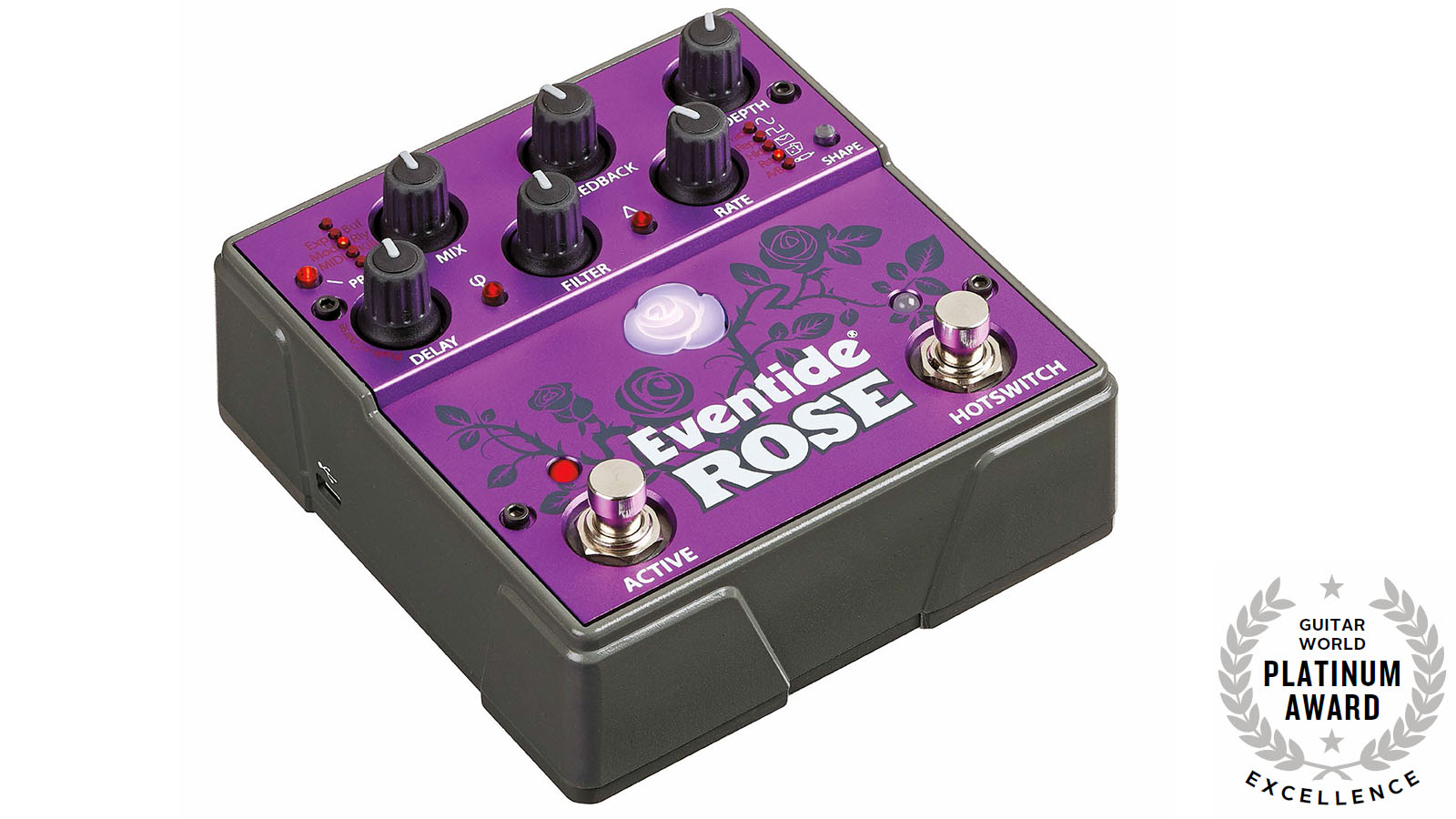Review: Eventide's Rose pedal offers a world of tones and textures
If you think that delay is played out as an effect, the Eventide Rose will change your outlook

When Eventide introduced its very first effect pedals - the Factor series - back in 2007, the company established a new standard for stomp boxes that many competitors are still catching up to. The revolutionary H9 Harmonizer, the follow-up to the Factor Series, came out in 2013, and it’s taken Eventide another six years to introduce its next and most recent pedal, the Rose. Unlike most other pedal manufacturers that deliver several new stomp box models every year, Eventide seems to release new pedals only when it has a bold statement to make.
Although the Eventide Rose may seem like a relatively modest and somewhat simple delay pedal compared to the incredibly advanced H9, it actually takes modulated delay effects to an entirely new level of complexity and expressive capabilities beyond any delay pedal ever offered before. Rose combines analog circuitry for filtering, mixing and feedback with a sophisticated digital delay line that provides delay times from 10 microseconds to 50 seconds to create incredibly intricate effects with rich, highly musical tone and texture. As a result, Rose delivers classic delay effects, as well as new sounds that competitors certainly will be trying to duplicate over the next decade.
FEATURES With only six control knobs (delay, mix, filter, feedback, rate and depth), four switches (preset, function, delay multiplier and shape) and two footswitches (active and Hotswitch) on its top panel, the Eventide Rose appears similar to many other delay pedals available today. However, the modulation section is impressively advanced, offering a selection of sine wave, square wave, envelope, random or external modulation sources and a choice of comb delay, flip phase, long delay and reverse delay functions; all accessed via the top panel switches. The Delta multiplier (modulation sweep) changes the sample rate, and can be set from two times or up to five times the standard delay time, and allows you to pitch up and/or down a full octave, an octave and a fifth, two octaves, and two octaves and a third. Rose also provides five presets with A/B variations that users can edit and save.
The pedal’s rear panel is similarly simple yet deceptively deep. In addition to ¼-inch mono input and output jacks with a mini switch for selecting guitar or line input levels, there is a TRS input for an expression pedal, auxiliary switch or MIDI. A mini USB jack on the side accommodates software updates, MIDI or preset management via a computer. The top panel Hotswitch footswitch can be assigned for tap tempo, infinite repeat, A/B switching, LFO hold or LFO reset functions, and bypass can set to relay, buffered or input kill settings.
By simultaneously holding down the bypass and Hotswitch footswitches, users can load presets and select them with the Hotswitch instead of via the preset switch. The Hotswitch can also control the delay multiplier and Phase/Reverse in addition to the listed functions.
PERFORMANCE Other companies may eventually figure out how to copy the distinct effects that the Eventide Rose is capable of producing, as Rose delivers truly professional, pristine sound quality with responsive expressiveness that’s in a class of its own. Rose offers all of the garden variety modulated delay effects like slapback echo, chorus and even rotating-speaker-style vibrato, but all of these effects stand out for their clarity, depth and body that’s unlike anything else out there. Rose is even more impressive for the entirely new effects it offers that are sure to become standards of the modern guitarist’s vernacular, with trippy, whammy-style pitch modulation, rich warmth courtesy of its analog low-pass filter and unusual “hyper-speed” textures. There’s currently nothing else that sounds like it on the market.
Unlike Eventide’s previous pedals, which could be challenging to program and operate, Rose is extremely simple to use. Every setting is accessed via the knobs and switches on the top panel, and there are no cryptic displays or pages of parameters to scroll through. Some functions require pressing and holding a switch or combination of switches to access them, but these are easy to remember once you’ve performed them a few times. Rose is so easy to use that Eventide only provides a six-page, quick-reference guide as a manual.
Get The Pick Newsletter
All the latest guitar news, interviews, lessons, reviews, deals and more, direct to your inbox!
If you think that delay is played out as an effect, the Eventide Rose will change your outlook. A great delay pedal is truly an instrument unto itself, and Rose adds a whole new world of tones and textures to explore and inspire creative ideas.
STREET PRICE: $349
MANUFACTURER: Eventide, eventideaudio.com
● The digital delay section provides delay times that range from an incredibly short 10 microseconds up to 50 seconds.
● The modulation section’s analog circuitry handles low-pass filtering, mixing and feedback functions to provide outstanding warmth and rich textures.
● The pedal stores five presets each with its own A/B variations that can be accessed via the top panel footswitches.
● A choice of comb delay, flip phase, long delay and reverse delay functions are available.
THE BOTTOM LINE
The Eventide Rose may be “just” another delay pedal, but its advanced digital delay and outstanding analog modulation section provide a whole new world of effects and textures that will certainly define guitar tones for decades to come.
Chris is the co-author of Eruption - Conversations with Eddie Van Halen. He is a 40-year music industry veteran who started at Boardwalk Entertainment (Joan Jett, Night Ranger) and Roland US before becoming a guitar journalist in 1991. He has interviewed more than 600 artists, written more than 1,400 product reviews and contributed to Jeff Beck’s Beck 01: Hot Rods and Rock & Roll and Eric Clapton’s Six String Stories.










